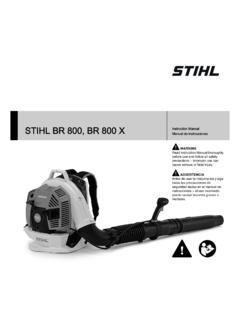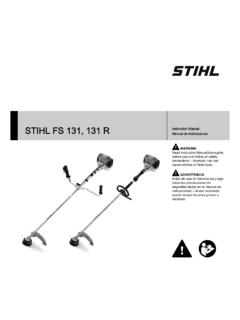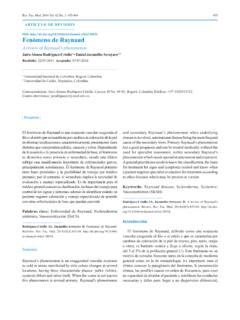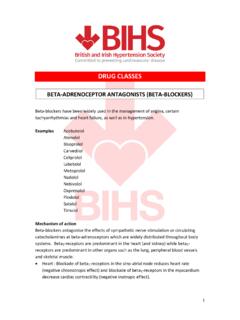Transcription of Screening and Laboratory Diagnosis of Autoimmune Diseases ...
1 Screening and Laboratory Diagnosis of Autoimmune Diseases Using Antinuclear Antibody Immunofluorescence Assay and Specific Autoantibody Testing Paul P. Doghramji, MDEducational support provided by Quest Diagnostics, Inc. 2 Autoimmune Diseases occur when the immune system attacks the normal tissue within joints, vasculature, and other organ systems, causing inflammation, pain, diminished mobility, fatigue, and other non-specific The strong overlap of signs and symptoms among the Autoimmune Diseases can lead to delays in Diagnosis and appropriate treatment. According to a survey by the Autoimmune Diseases Association, it takes up to years and nearly 5 doctor visits to receive a proper Autoimmune disease Laboratory testing, in addition to clinical assessment, is necessary for differential Diagnosis and disease classification of Autoimmune Diseases .
2 However, research shows that primary care physicians tend to overuse common autoantibody tests for Autoimmune conditions, which can limit the positive predictive value and clinical utility of such To facilitate appropriate referral to specialists, if necessary, Laboratory testing should be reserved for patients who have signs and symptoms consistent with one or more Autoimmune disease (Table 1). The antinuclear antibody (ANA) immunofluorescence assay (IFA) is a first-line Screening test for patients with a suspected Autoimmune disease . This test is the gold standard because of its high sensitivity compared to other ,5 Positive results should prompt clinicians to continue investigating the cause of a positive ANA IFA and narrow the field of potential culprits.
3 The following describes how ANA IFA in combination with specific autoantibody testing can be used in the differential Diagnosis of a suspected Autoimmune Screening and diagnostic testing for disease classification The recommended ANA screen approach uses HEp-2 human tissue culture cells in an IFA. In this assay, the patient s blood sample is mixed with HEp-2 cells fixed to a slide. ANAs present in the sample react with the cells and treatment with a fluorescent anti-human IgG antibody allows visualization of antibody binding under fluorescence microscopy. This test screens for a large number of known autoantibodies, approximately 150, directed against nuclear antigens and cell cytoplasm. A positive screen result is followed by evaluation of antibody titer and pattern (consult side bar below).
4 With a positive ANA IFA screen and titer, the clinician needs to determine the root cause of the positivity. This can be accomplished through a reflex to an algorithm of specific antibody tests to help identify autoantibodies associated with specific Autoimmune Diseases . An ANA reflex algorithm tests for specific antibodies in a clinically logical sequence. With a combination of ANA IFA plus a reflex algorithm of specific antibody testing, positive results automatically reflex to a tier of disease -specific autoantibodies. Testing begins with the most prevalent Autoimmune Diseases and continues until a positive result is found, or all tests in the algorithm have returned a negative result. This algorithm/reflex approach provides the clinician with a rational approach to confirming a Diagnosis in a patient with a suspected Autoimmune disease , with a single blood draw.
5 Titer and PatternIf the ANA IFA screen is positive, testing for antibody titer and pattern can help evaluate the presence and type of autoantibody disease . ANA titers are determined by diluting the liquid portion of the blood sample in saline at a ratio of 1:40 to 1:1280. The titer is thus the highest dilution that yields a positive ANA result. Any titer above 1:40 is considered positive, and titers above 1:80 are consistent with an Autoimmune disease . To assess the nuclear and cytoplasmic staining patterns of samples with positive results, patient antibodies react with indicator cells and the localization of patient antibodies is visualized by a second fluorescein antihuman IgG antibody evaluated under a fluorescence microscope. These patterns may provide additional information to rule out or further implicate a suspected condition and can guide the selection of additional testing for specific Figure 1 above illustrates an example of an algorithm approach with a set of reflexing tiers for suspected rheumatic disease , a more common group of Autoimmune With this algorithm, samples with a positive IFA result are tested for five autoantibodies associated with systemic lupus erythematosus (SLE) and mixed connective tissue disease : dsDNA, chromatin (nucleosomal), Smith (Sm), ribonuclear protein (RNP), and Sm/RNP antiodies.
6 Tier 1 Chromatin, dsDNA, RNP, Sm, and Sm/RNP antibodiesTier 2Jo-1, Scl-70, SS-A, and SS-B antibodiesANA Screen (IFA) NegativePositiveTiter and Patt er nNegativeNegativeNegativePositivePositiv ePositiveNo evidence of rheumatic disease shown by analyt es tes tedTier 3 Centromere B and ribosomal P antibodiesAntibody Tes tSy stemic Lupus ErythematosusMixed Connective Tissue Diseaseds DNA Chromatin+ (h igh sensi tivity) Sm Sm/RNP++ (h igh titer)RNP++ (h igh titer)Antibody Tes tSj gren s Syndrome SS-A + SS-B + Scl-70 Jo-1 Sy stemic Scler osis + Pol ymyositis +Antibody Tes tCREST SyndromeNeuropsychiatric SLEC entromere B+ Ribosomal P + This figure was developed by Quest Diagnostics based on references 1-5. It is provided for informational purposes only and is not intended as medical advice. A physician s t est s election and interpretation, Diagnosis , and patient management decisions should be based on his/her education, c linical expertise, and assessment of t he Kavanaugh A, Tomar R, Reveille J, et al.
7 Guidelines for clinical use of the antinuclear antibody test and tests for specific autoantibodies to nuclear antigens. Arch Pathol Lab Med. 2000;124:71-81. 2. Sa toh M, Chan EKL, Sobel ES, e t al. Clinical implication of aut oantibodies in patients with systemic rheumatic Diseases . Expert Rev Clin Immunol. 2007;3:721-738. 3. Sti nton LM, Frit zler MJ. A clinical approach to autoantibody testing in systemic Autoimmune rheumatic disorders. Autoimmun Rev. 2007;7:77-84. 4. Petri M, Orbai AM, Alarc n GS, et al. Derivation and validation of systemic lupus international collaborating clinics classification criteria for systemic lupus erythematosus. Arthritis Rheum. 2012;64:2677-2686. 5. Cappelli S, Randone SB. T o be or not t o be, t en years after: e vidence for mixed connective tissue disease as a distinct entity. Semin Arthritis Rheum.
8 2012;41:589-598. Figure 1. Use of ANA (IFA) and Specific Antibody Testing Cascade (Test Code 16814) for the Diagnosis of Rheumatic disease + (h igh specificity)+ (h igh specificity)The acronym CREST refers to a syndrome defined by presence of calcinosis, raynaud s phenomenon, esophageal dysmotility, sclerodactyly, and telangiectasia. dsDNA indicates double-stranded DNA; S m/RNP antibody, S mith/ribonucleoprotein antibody; S S-A and -B antibodies, Sj gren s Syndrome A and B antibodies; S cl-70 antibody, s cleroderma (topoisomerase I) antibody; J o-1 antibody, histidyl-tRNA synthetase antibody; and SLE, s ystemic l upus erythematosus. Autoimmune disease less likely. May consider rheumatoid arthritis disease acronym CREST refers to a syndrome defined by presence of calcinosis, raynaud 's phenomenon, esophageal dysmotility, sclerodactyly, and telangiectasia.
9 DsDNA indicates double-stranded DNA; Sm/RNP antibody, Smith/ribonucleoprotein antibody; SS-A and -B antibodies, Sj gren's Syndrome A and B antibodies; Scl-70 antibody, scleroderma (topoisomerase I) antibody; Jo-1 antibody, histidyl-tRNA synthetase antibody; and SLE, systemic lupus erythematosus. This figure was developed by Quest Diagnostics based on references 6-10. It is provided for informational purposes only and is not intended as medical advice. A physician s test selection and interpretation, Diagnosis , and patient management decisions should be based on his/her education, clinical expertise, and assessment of the 1. Use of ANA (IFA) and Specific Antibody Testing Cascade (Test Code 16814) for the Diagnosis of Rheumatic Disease6-10(In the cell, Sm and RMP proteins form a complex.) If the first tier yields a positive result, the results are reported and the testing stops.
10 If the first tier of antibody testing is negative, the testing reflexes to the 2nd tier, which includes four autoantibodies associated with Sj gren s Syndrome, systemic sclerosis, and polymyositis: SS-A, SS-B, Scl-70, and Jo-I antibodies. If a positive result is determined for any of these autoantibodies, the results 4 Sign or Symptom GoutJIAMCTDPM/DMPseudogoutRASarcoidosisJ oi nt-/muscle-r elatedJo int pain, stiffness,or inflammation Muscle weaknessMyalgiaSkin-/hai r-relatedAlopeciaRashRaynaud s phenomenon Skin lesionsGeneralAnor exiaCoughEar involvementEye involvementFatigueFeverGI involvementMalaiseNasal symptomsNer vous system involvementRespirator y involvementWeight lossOtherAdenopathyAnemiaDysphagiaSwelli ng of hands(Contin ued)cdTable 1. Common Signs and Symptoms of Autoimmune Rheumatic and Related Diseasesa,b5 Sign or Symptom SjSSLEAS ReA PsA EASScGPA EGPA MPAS ystemic VasculitisSpAJoi nt-/muscle-r elatedJo int pain, stiffness,or inflammation Muscle weaknessMyalgiaSkin-/hai r-relatedAlopeciaRashRaynaud s phenomenon Skin lesionsGeneralAnor exiaCoughEar involvementEye involvementFatigueFeverGI involvementMalaiseNasal symptomsNer vous system involvementRespirator y involvementWeight lossOtherAdenopathyAnemiaDysphagiaSwelli ng of handsd indicates common.















